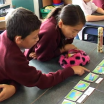Provide options to create, learn and share
Provide flexible options and tools so year 9-13 students can show their learning and share with others.
On this page:
On this page:
Current page section: Provide options to create, learn and share
Go to top of current page: Provide options to create, learn and share
Go to top of current page: Provide options to create, learn and share
Go to top of current page: Provide options to create, learn and share
Offer a range of materials and supports
Offer a range of materials and supports
Provide a range materials and support for students to express what they know in a variety of ways.
- Create opportunities where students can personalise learning tasks and build on their knowledge, experience and strengths.
- Develop success criteria with the students and present it clearly supported with visuals.
- Structure collaborative activities so that each student knows what is expected of them.
- Create opportunities for students to gain confidence in a range of media so that they can select the most appropriate way to express and share their thinking and learning.
- Make learning support tools (text-to-speech, graphic organisers, planning tools and so on) available to everyone.
- Assess understanding and presentation separately.
Offer options for sharing learning
Offer options for sharing learning
Provide a range of ways for students to express what they know.
For example, using multimedia, talking books, images, symbols, voice recordings and videos.
Closed Captions
Notice, recognise and respond to ākonga progress
Notice, recognise and respond to ākonga progress
Notice ākonga progress in authentic and everyday contexts. Recognise ākonga progress in learning and respond by adapting practice to learning needs.
- Use everyday classroom observations and conversations to notice learning progress.
- Use a progressions based approach to recognise achievement and next steps.
- Respond to learner progress by planning and modifying teaching to meet ākonga needs.
- Use ‘noticing, recognising and responding’ as a basis for reporting ākonga achievements to parents.
- Use real time reporting tools to document student learning as it happens and share progress with whānau. For example, use Student Management System parent portals, apps and shared online platforms.
- Make learning visible. When learning is visible, ākonga know what they need to learn, where they are at with that learning, and what their next learning steps are.
- Empower ākonga to be active participants in recognising their learning progress. For example, co construct progression and assessment rubrics.
Personalise assessments
Personalise assessments
Personalise learning and assessment.
- Create timelines, expectations and NCEA programmes in collaboration with the learner, their whānau and their learning support team.
- Design learning and assessment programmes to meet the unique needs of each ākonga.
Identify assessment formats and digital technologies to accurately measure the learner’s learning using their strengths. Options depend on purpose and formal assessment criteria but may include:
- Write using paper and pen
- Write using a keyboard and digital supports such as spell checking and dictionary options
- Write using voice typing
- Create visuals or graphics
- Create multimedia books or slides
- Create videos or animations
- Create audio recordings or podcasts
- Timed, untimed and on demand tests.
Identify Special Assessment Conditions needs
Identify Special Assessment Conditions needs
Special Assessment Conditions (SAC) can provide extra help for otherwise capable students to address barriers to achievement in assessments for NCEA or New Zealand Scholarship. For example, a student who uses NZSL may need a reader who can use sign-assisted English.
Support external assessments
Support external assessments
- Offer students mock or practice assessments so they know what to expect and can become familiar with formats and assessment environments.
- Identify possible barriers in the physical environment, for example, unfamiliar room layout, lighting, or temperature.
- Support time management with visual timers and calendar tools.
- Teach and practise approaches to managing anxiety, such as mindfulness and positive self-talk, and identify solutions to anticipated problems prior to an assessment.
- Pre-teaching specific assessment or exam skills, such as how to approach multiple choice questions.
Next steps
More suggestions for implementing the strategy “Helpful classroom strategies years 9-13”:
-
Current page Provide options to create, learn and share
Return to the guide “Speech, Language and Communication”

Speech, Language and Communication
How to use this site
Guide to Index of the guide: Speech, Language and Communication
Strategies for action:
-
Identify needs and how to provide supportShow suggestions for Identify needs and how to provide support
-
Key areas to supportShow suggestions for Key areas to support
-
Helpful classroom strategies years 1-8Show suggestions for Helpful classroom strategies years 1-8
-
Helpful classroom strategies years 9-13Show suggestions for Helpful classroom strategies years 9-13
- Build language-rich environments
- Support participation and build confidence
- Present information in different ways
- Support processing and planning
- Provide options to create, learn and share
